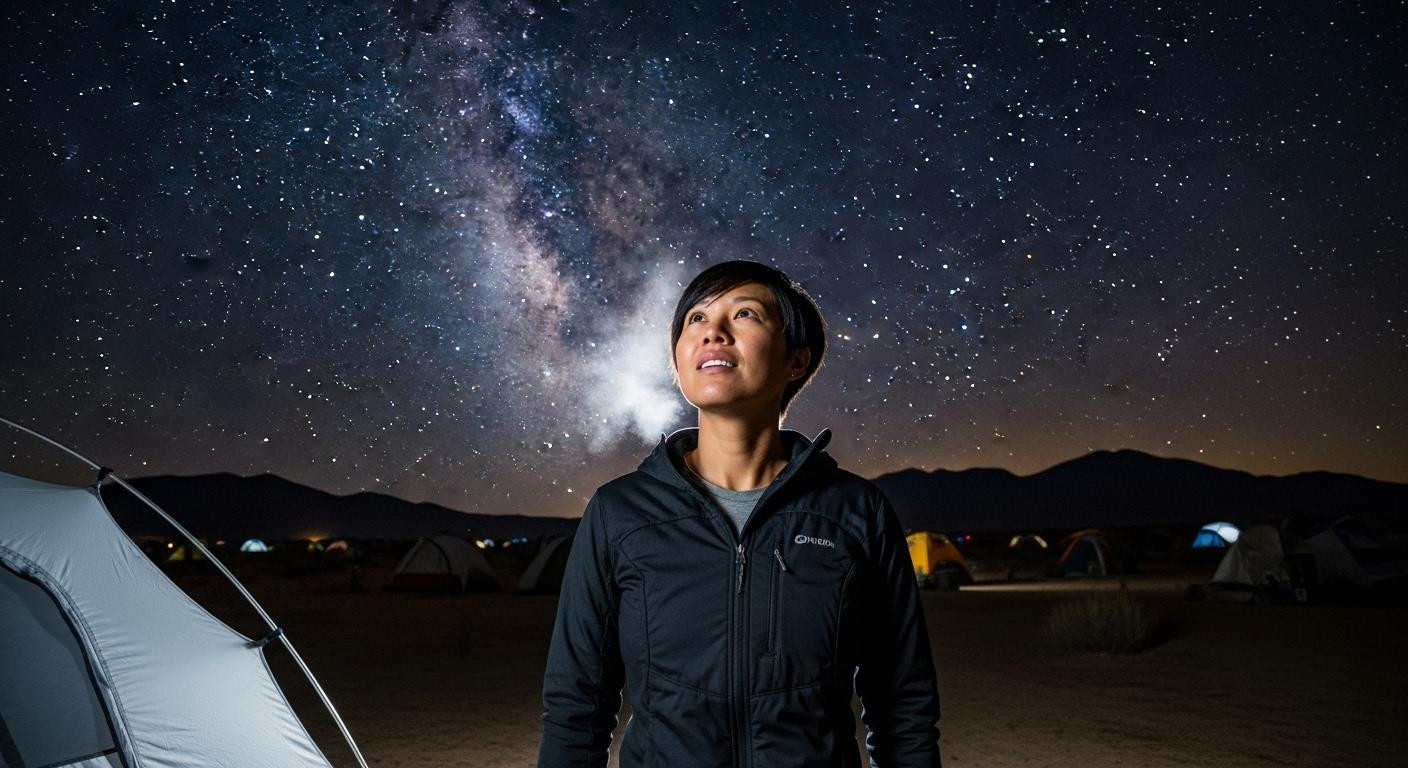At 4:30 AM, your breath forms small clouds in the 42°F desert air of Great Basin National Park. Above you, the Milky Way stretches across a Bortle 1 sky so dark that Venus casts shadows on your tent. Three months ago, this same campsite hit 89°F by dawn with RVs packed shoulder to shoulder. Now, in late October’s secret window, only 12 tents dot the entire campground.
This is America’s overlooked stargazing season. While summer tourists battle heat and crowds, autumn nights offer the year’s clearest skies, comfortable sleeping temperatures, and solitude beneath infinite stars.
When America’s dark skies actually peak
The counterintuitive truth about stargazing timing challenges everything tourists believe. Summer’s warm nights come with humidity, atmospheric turbulence, and light pollution from packed campgrounds. Late September through early November delivers stable air, reduced moisture, and desert locations that drop rates 35% when crowds disappear.
Regional visitor centers confirm that atmospheric conditions optimize during autumn’s temperature transitions. Cool desert nights at 45-65°F create thermal stability that eliminates the shimmer affecting summer stargazing. Cherry Springs State Park documentation states that fall and winter offer “lessened humidity and extended night-time hours” creating “excellent stargazing opportunities.”
Great Basin National Park records 90,000 annual visitors compared to Joshua Tree’s 3.4 million. Yet astronomy clubs book Great Basin’s October dates first, knowing that Wheeler Peak’s 13,063-foot elevation combined with autumn’s dry air produces supernatural clarity.
The science behind fall’s superior stargazing
Atmospheric science explains October’s stargazing advantage through measurable phenomena. Temperature inversions common in autumn create stable air layers that reduce stellar scintillation. Desert locations show dramatic improvements as humidity drops from summer’s 60% to autumn’s 25%.
Temperature sweet spots for comfortable sleeping
Joshua Tree’s October nights range from comfortable 57°F lows to pleasant 77°F highs. Great Basin offers cooler conditions with October 1st at 72°F dropping to October 31st at 35°F. These temperatures eliminate summer’s sleep-disrupting heat while staying above freezing for standard camping gear.
Crowd disappearance and natural darkness
Visitor statistics reveal autumn’s dramatic crowd reduction. National forest camping locations with fewer than 200,000 annual visitors become nearly empty post-Labor Day. Campground occupancy drops from summer’s 95% to October’s 40%, reducing light pollution from headlamps, campfires, and vehicle traffic.
Six locations and their precise peak windows
Each dark sky destination offers specific timing advantages based on elevation, climate, and astronomical events. Professional astronomy organizations book these windows 4-5 months ahead, according to Cherry Springs State Park staff recommendations.
Great Basin and Cherry Springs: late September through mid-October
Great Basin’s high desert location provides optimal conditions before November’s potential snow. Cherry Springs State Park’s rustic campground operates mid-April through late October, making October visits time-sensitive. Both locations benefit from new moon phases that coincide with stable autumn weather patterns.
Joshua Tree and Big Bend: mid-October through early November
Desert locations maintain comfortable temperatures longer into autumn. Joshua Tree’s October weather shows only 1 expected rainy day with comfortable sleeping conditions. Budget outdoor adventures in forest locations complement desert stargazing with diverse terrain options.
What astronomy clubs know and book first
Local astronomy organizations protect October’s advantages through strategic booking patterns. Cherry Springs hosts major star parties in June and September, but astronomy club members return individually in October for personal viewing sessions. The Black Forest Star Party 2025 sold out completely for its September dates, demonstrating demand for autumn events.
Professional stargazers understand that October’s combination of stable weather, reduced crowds, and optimal celestial positioning creates conditions superior to publicized summer events. October destinations offering 40% savings while maintaining peak experiences reflect this seasonal timing advantage.
An innkeeper near Cherry Springs who’s hosted astronomy enthusiasts for two decades notes that repeat visitors consistently choose October dates, avoiding both summer’s heat and winter’s unpredictable weather.
Your questions about sleeping under America’s stars answered
Do I need expensive equipment for October stargazing?
No telescope required for spectacular naked-eye viewing in Bortle 1 locations like Great Basin. A warm sleeping bag rated to 20°F handles October temperatures comfortably. Park entry fees range from $15-30, with camping costs $20-50 per night. Basic stargazing apps help identify constellations without expensive equipment purchases.
How cold does it actually get at night in October?
Joshua Tree maintains comfortable 57-77°F ranges throughout October. Great Basin varies more dramatically, with early October at 72°F cooling to 35°F by month’s end. Cherry Springs averages 40-60°F for comfortable sleeping with appropriate gear. Layering systems work better than single heavy items for temperature fluctuations.
Is October really better than summer for the Milky Way?
Yes, atmospheric conditions in October create sharper stellar definition than summer’s humid air. The Milky Way’s galactic center remains visible until early November while benefiting from autumn’s stable atmospheric conditions. Photography enthusiasts report superior contrast and detail during October sessions compared to summer attempts.
Your headlamp clicks off at midnight in Great Basin’s campground. October stars hang so dense overhead they illuminate your tent’s interior. The temperature holds steady at 45°F, perfect for sleeping bags and clear skies. Tomorrow you’ll understand why astronomy clubs guard this secret: autumn offers more than stars, it offers solitude beneath them.
